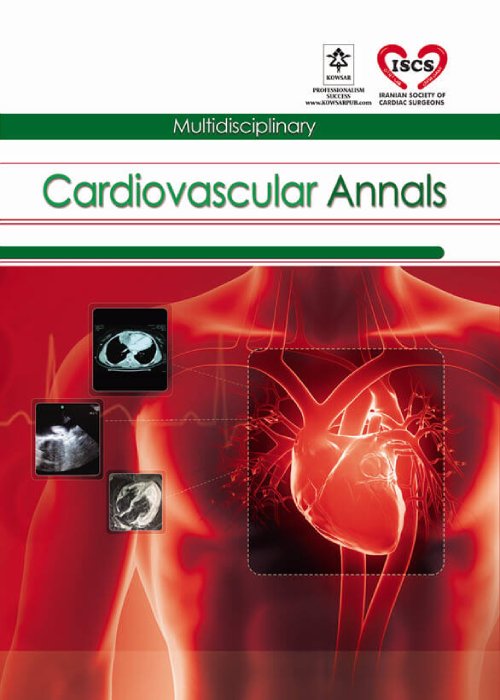فهرست مطالب
Multidisciplinary Cardiovascular Annals
Volume:1 Issue: 4, Jun 2007
- تاریخ انتشار: 1384/11/25
- تعداد عناوین: 9
-
-
Page 3
-
Page 9ObjectiveTo evaluate the surgical treatment of total anomalous pulmonary venous connection (TAPVC) and determination of predictors for postoperative death.Method & Material: Between 1995 and 2005, 80 patients aged from 1 month to 12 years underwent surgical repair for supracardiac (39), Cardiac (34), infracardiac (3) or mixed (4) type of TAPVC. There were an atrial communication in all patients, large PFO in 23% and ASD in 77%. Systemic pulmonary hypertension (PH) in 53.8% of patients, half systemic PH in 26.3% and mild PH (<40 mmHg) were found by preoperative evaluations. Twelve patients (15%) had some degrees of pulmonary vein obstruction preoperatively.ResultsSeven patients (8.7%) died in the operating room. Early postoperativemortality (during 48 hours) occurred in 11 cases (13.7%) and nine patients died during first hospitalization. We did not have late mortality in survivors during follow-up period; therefore the overall mortality rate was 33.8%. Heart failure and low cardiac output syndrome were the most common causes of death. The incidence of postoperative death was the highest in infracardiac type (2/3). Approximately two thirds of dead patients (21/27) had presented with systemic PH and 89% of them had at least half-systemic PH preoperatively. Mortality rate in patients with normal Pulmonary artery pressure (PAP) was zero
-
Page 15Back ground:Since the first Fontan operation, various techniques have been described. These methods have been changed during the time. Now new drugs are also being used beside surgery. Case reports:Fifteen patients with mean age of 8 years and diagnosis of tricuspid atresia or D TGA and single ventricle were operated in our hospital. All of them, except one were operated with extra cardiac technique and fenestration was created in half due to CVP (In seven cases). We had one mortality and three case of postoperative morbidities. The major complications were pleural and pericardial effusion and chylothorax. We treated two patients inflicted with effusion with oral Sildenafil sulfate(Viagra) therapy.ConclusionThe mortality in our study was comparable to other studies. We prefer to have a fenestration between conduit and RA even with low CVP. Oral Sildenafil therapy would reduce pulmonary artery pressure in complicated patients.Keywords: Fontan operation, Fenestration, Sildenafil sulfate
-
Page 17BackgroundTwo recent meta-analyses demonstrated that angiotensin converting enzyme inhibitors (ACEIs) and angiotensin receptor blockers (ARBs) reduce the risk of developing new-onset atrial fibrillation (AF) by nearly 50%. However, the ability of ACEIs or ARBs to prevent postoperative atrial fibrillation (POAF) after cardiac surgery has not been adequately evaluated.ObjectiveTo evaluate the impact of preoperative ACEI or ARB use on the incidence of POAF after cardiac surgery.MethodsPatients undergoing coronary artery bypass grafting and/or valvular surgery from the (atrial fibrillation suppression trials II and III (AFIST II and III) randomized, controlled trials were evaluated in this cohortevaluation. Data in respect to patient demographics, surgical characteristics, medication utilization and the incidence of POAF (defined as AF lasting at least 5 min in duration documented by telemetry) were all uniformly and prospectively collected as part of AFIST II and III. Multivariate logistic regression was utilized to calculate adjusted odds ratios with 95% confidence intervals.ResultsA total of 338 patients were evaluated of which 175 (51.8%) received an ACEI or ARB preoperatively and 163 (48.2%) did not. The study population was 65.7 ± 9.1 years of age, 77.8% were male, 11.2% underwent valve surgery, 3.6% had prior AF, 10.1% had heart failure and 84.0 and 37.9% received postoperative beta-blockade and prophylactic amiodarone, respectively. In total, 110(32.5%) patients developed POAF. Upon multivariate logistic regression, the preoperative use of an ACEI or ARB was not found to be associated with a statistically significant reduction in POAF (adjusted odds ratio; 0.71, 95% CIs 0.42–1.20).ConclusionsAlthough preoperative ACEI or ARB use reduced the odds of developing POAF by 29%, this association with not found to be statistically significant. A study with approximately 600 subjects would be needed to discern if ACEIs or ARBs truly impact POAF.Keywords: Postoperative atrial fibrillation, Reninangiotensin, system, Cardiac surgery
-
Page 29Coarctation of the aorta is commonly associated with congenital and acquired cardiac pathology that may require surgical intervention.[1,2]In addition,5% to 30% of patients with previous coarctation repair have recoarctation and require reintervention[3-5].Adult patients with native or recurrent coarctation with or without associated intracardiac diseases pose a surgical challenge.There is no consensus on the optimal approach for these patients.Several extra-anatomic bypass grafting techniques have been described,including methods in which the distal anastomosis is performed on the descending thoracic aorta,supraceliac abdominal aorta,or the infrarenal abdominal aorta.[3,4,6-9] In 1980,Vijayanagar et al[10] described exposure of the descending thoracic aorta through a median sternotomy and posterior pericardium.This procedure allowed bypass of coarctation with concomitant aortic valve replacement. Aditional reports detail modifications of this procedure for complex forms of aortic coarctation[11].The present case report reviews two cases of recurrent coactation that underwent ascending to descending aortic bypass
-
Page 33
-
Page 35
-
Page 37


